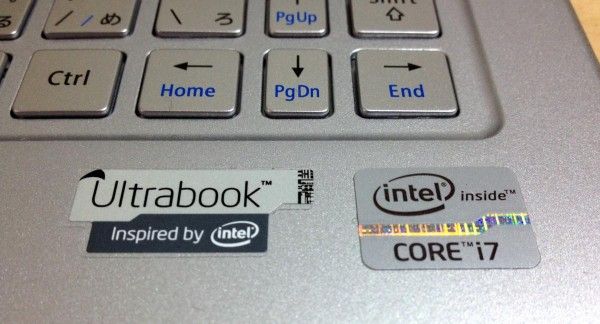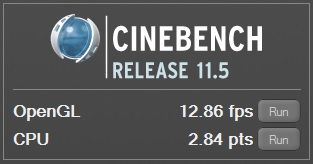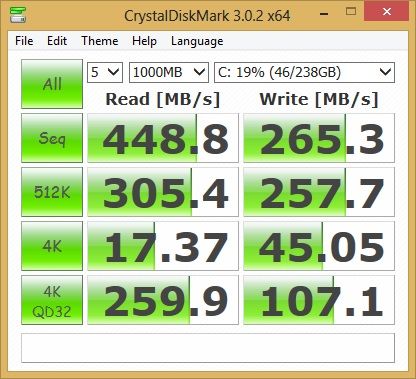Performance
The Lavie Z we tested uses the Intel Core i7-3517U @ 1.9GHz, perhaps the fastest processor that you can find in any Ultrabook currently on the market. On-board HD 4000 graphics are included as well, though you shouldn’t expect much satisfaction with modern titles from it.
The Lavie Z handled Photoshop CS6 very well, but when it came to Minecraft it seemed to underperform compared to similar HD 4000 equipped Ultrabooks. You could get a pleasant 30 FPS out of Minecraft with Far render distance and Fast graphics, but we’ve seen between 50 and 60 FPS on other Ultrabooks with the same settings. The reason for this is not clear — it could be related to Java performance on Windows 8, or NEC may have tuned the graphics clock down to help with battery life.
Turbo Boost
The first thing we looked into was that Turbo Boost was functioning properly. Turbo Boost dynamically increases the speed of the CPU to meet the load on the system. Intel rates the i7-3517U at 1.9GHz, but Turbo Boost can take this all the way up to 3.0GHz if needed.
In the past we’ve seen systems that either weren’t boosting properly or weren’t always dropping down to idle. The former would reduce performance while the latter would reduce battery life. For this reason it’s important to make sure that Turbo Boost is working as intended — you can read our guide about making sure that Turbo Boost is working correctly for your own machine.
We used Intel’s Turbo Boost monitor to make sure that things were working properly and indeed they were. In addition to boosting correctly under load, the Energy Saver mode enabled with no issues.
Boot and Resume Times
The Lavie Z shows that Ultrabooks have basically become instant-on machines, it resumes from sleep in less than 1 second. This is something that Intel has been working toward for a long time, and this is the first Ultrabook where it doesn’t just feel fast — it feels instantaneous.
When you approach the sleeping Lavie Z on a table, it is awake by the time you finish lifting up the lid:
Though it’s really the sleep and wake times that are most important, boot and shutdown times are great as well. Rather than going to make a cup of coffee during a restart, as on some other machines, you’ve hardly got time to respond to a text message before the Lavie Z is ready to work after a restart.
- Sleep (standby): 2.9 seconds
- Wake (from standby): 1.5 seconds
- Boot: 9.5 seconds
- Shutdown: 7 seconds
- Full Restart: 18.7 seconds
Benchmarks
Running performance test suites gives you a benchmark with which to roughly compare against other devices. Tests done with NEC Lavie Z plugged-in and set to ‘High Performance’.
PCMark 7 – Organic Test
Other PCMark7 Ultrabook results (SB = Sandy Bridge, IB = Ivy Bridge):
- Gigbyte U2442V (Core i7 IB, discrete GPU): 5648
- Lenovo ThinkPad X1 Carbon (Core i7): 4832
- Lenovo Ideapad Yoga 13 (Core i7 IB): 4615
- Samsung Series 9 [2012] (Core i5 IB): 3679
- Lenovo U310 (Core i5 IB): 3545
- Asus UX21E (Core i7 SB): 3358
- Samsung Series 9 15-inch [2012] (Core i5 IB): 3129
- Lenovo U300s (Core i7 SB): 3280
- Toshiba Z830 (Core i5 SB): 2885
- Samsung 900X1B (Core i3 SB): 2508
- Acer Aspire S3 (Core i5 SB): 1967
- Samsung Series 5 (Core i5 SB): 1894
CineBench — CPU and GPU
Other CineBench Ultrabook results:
- Lenovo ThinkPad Twist (Core i5 IB)
- CPU: 2.34
- OpenGL: 10.73
- Lenovo Ideapad Yoga 13 (Core i7 IB)
- CPU: 2.23
- OpenGL: 13.44
- Lenovo U510(Core i5 IB)
- CPU: 2.38
- OpenGL: 10.73
- Samsung Series 9 [2012] (Core i5 IB)
- CPU: 2.38
- OpenGL: 15.63
- Lenovo U300s (Core i7 SB)
- CPU: 2.12
- OpenGL: 8.68
- Samsung Series 5 (Core i5 SB)
- CPU: 1.55
- OpenGL: 8.11
- Toshiba Z830 (Core i5 SB)
- CPU: 1.89
- OpenGL: 8.36
- Acer Aspire S3 (Core i5 SB)
- CPU: 1.63
- OpenGL: 7.51
- Samsung 900X1B (Core i3 SB)
- CPU: 1.25
- Asus UX21E (Core i7 SB)
- CPU: 2.11
CrystalDiskMark — SSD
The SSD in the NEC Lavie Z is the 256GB Samsung MZMPC256HBGJ-000L1 and it’s one of the faster SSDs that we’ve seen. This disk is likely the reason that the Lavie Z resumes nearly instantly from sleep. Small reads and writes (4k) are also quite fast which can be important when the computer needs to interact with discrete non-sequential files. The computer reads 238GB of space available despite it being a 256GB disk.
Battery Life
Battery life testing is currently underway, results will be updated soon.















Great review Ben.
Zero bloatware is a true advantage and I think most Dynamism imports are built this way. Good job Dynamism.
Looking forward to batery life tests.
Chippy.
Cool stuff but will never every buy a ultrabook with 2 or less USB-ports again. Hope this trend doesnt stay, my freaking 500$ old 10inch notebook had freaking 3 usb-slots.
great device all ultrabooks should aspire to that weight sadly it is not readily available in europe it is something for the japanese market right?
In theory Lenovo has rights to rebrand and release it outside of Japan due to their deal with NEC.
Is the power plug compatible with the Thinkpad X1C adapter? It sure looks that way.
Hoping the battery life scores are decent. Probably still not enough for me, but maybe the Haswell version might be.
The HD 4000 is most probably underperforming other ultrabooks because the processor overperforms. CPU+GPU share overall TDP so more energy consuption by the CPU limits the energy available to the GPU, which is in effect throttled more aggressively.
Hence on Ultrabook with today’s generation of core it generally makes more sense not to have the fastest cpu, and even to have an i5 instead of an i7, even if it seems less sexy.
It could also be set to battery mode instead of performance mode. (in the GPU control panel)
I used our guide on maximizing Ultrabook perfromance (http://ultrabooknews.com/2012/07/12/how-to-optimize-your-ultrabook-for-maximum-gaming-performance/) before running the tests, so it should have been at top performance. I’m thinking that NEC turned down the graphics to help the battery life.
Did you get a chance to check CPU clockrate during tests. They may be using a tdp-down option which will limit CPU and affect the overall perf. The Samsung Series 5 for example, doesn’t have turbo enabled when on battery.
Strange indeed!
But one BIGGEST problem with them, – ONLY 4gb memory,that’s just a jole :(
I watched Intel’s Turbo Boost performance monitor during benchmarks and it seemed to be running at full power (but I think the graphics core might be separate).
Hi, could you elaborate a bit more on the vertical viewing angle? How much off center can you be before it starts to wash out? Also, how sturdy is the LCD hinge when the screen is open? Does it stay firmly in place or will it wiggle around? Lastly, any problems with the touchpad? I read some Japanese reviews and it seemed like people were complaining about it. Thanks.
Can you give review/test on color accuracy?
Thanks!